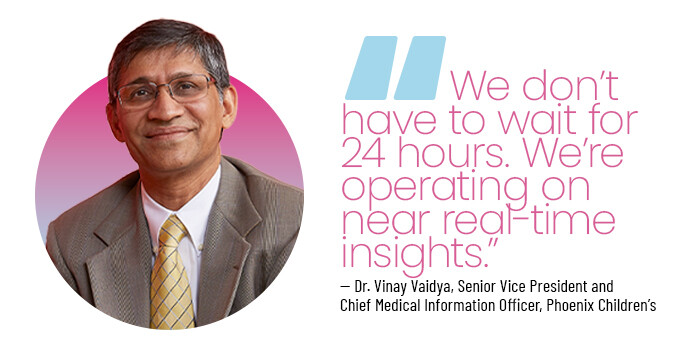Phoenix Children’s Integrates EHR With a Data Warehouse and AI
Working for 17 years with Phoenix Children’s, Vaidya has witnessed the evolution of the EHR within the large, Arizona-based pediatric organization, starting from a general system to one that includes more specialties, such as pulmonology and cardiology, he says. It all connects to a single EHR system that comprehensively incorporates inpatient and ambulatory areas and operating and emergency rooms.
Phoenix Children’s EHR journey consists of three phases: implementation, optimization and application, Vaidya adds. “Our third phase, which I think is the most important phase even before AI came into the picture, is bringing the EHR data back to all of the front-end people, the mid-level people, the leadership level. That has been a transformative experience at Phoenix Children’s in the past seven or eight years,” he says.
The discussion among clinicians has matured from focusing on the EHR to looking at what they can do with the data, such as researching how many patients in the health system have neurofibromatosis, a group of genetic disorders that can lead to tumor growth on nerves. Clinicians can then track this population closely to watch for early detection of malignant transformation, if any, Vaidya says.
READ MORE: Optimize your EHR and use data to improve clinical workflows.
Phoenix Children’s integrated a documentation tool in its central EHR to achieve structured data. Data flows into a homegrown, Microsoft-based data warehouse from the EHR in one-minute intervals, he notes. “We don’t have to wait for 24 hours. We’re operating on near real-time insights.”
More than 100 different electronic systems pull data into the data warehouse. The organization also uses Microsoft Power BI as its data visualization tool and is experimenting with connecting ChatGPT to the EHR platform using APIs “to summarize large volumes of clinical text and support ambient listening capabilities that can reduce documentation burdens,” Vaidya says.
Phoenix Children’s has begun using generative AI to help with chart summarization and EHR data analysis to predict malnutrition in kids.
“It was so successful that we put a policy in place that if the predictive model has identified malnutrition, we are automatically generating an order for the dietitians and the nutritionists to examine this patient without waiting for the physician,” Vaidya says.
The health system is also performing predictive analytics to detect sepsis risk earlier. These AI tools can provide “gentle nudges” to physicians rather than replacing them, he says.












